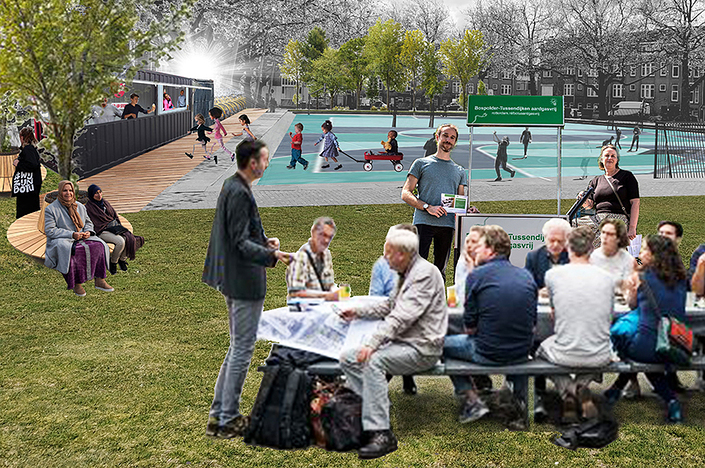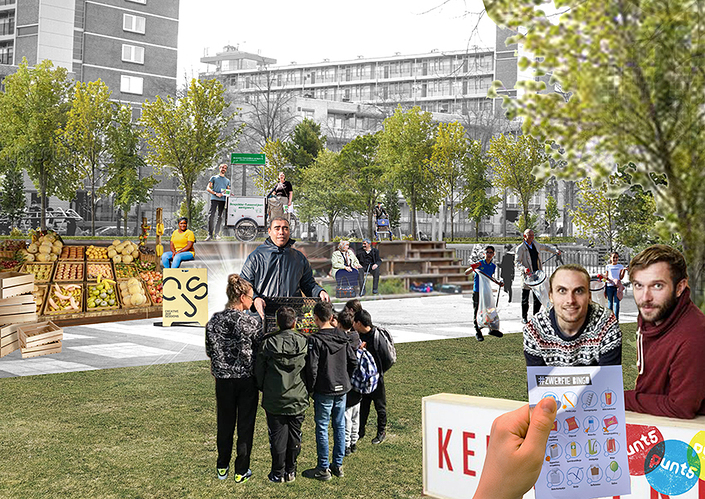Rotterdam has always been a showcase for attractive images but ignorant about addressing urban impurities, by post-war being built back as an intra- and international gateway. Fragmentation of the spatial planning system, politicization and polarization, and a lack of depth in important political discussions have resulted in urban impurities in municipal measures express in the absence of cross understanding regarding taking care of challenging focus areas, like Bospolder-Tussendijken (BoTu) in Rotterdam. According to Maud Ebbers, it is time to reconsider this approach.
Socio-spatial character is paradoxical. Social unrest creates a lack of responsibility to sustain and maintain the (semi)public space, causing a vicious cycle of unrest. Overstimulation with (sustainable or resilient) development plans sensitizes and therewith stigmatizes the neighbourhood. Residents are aware of this stigmatization and often find themselves in a self-fulfilling prophecy, not taking care of their surroundings. Passengers and residers move through the neighbourhood with shifting motives related to four domains of social life, living (1), labour (2), learning (3), and leisure (4). Urban planning documents are dominantly textual and theoretical, while they involve creating physical places with a practical outcome. No-boundary-botu could be the solution. By embracing asset-based community development and co-creating with the unusual suspects, an Asset Atlas could strengthen local networks and fit the needs of the different domains, aiming for true cross understanding. Through scenarios, synergies within the initiatives' network will be displayed to reclaim the (semi)public space, encourage encounters, create safety, trust and most importantly, rest
(Semi)Public discourse
“Arme wijken zijn een verzamelpunt van kwetsbare mensen. Gevolg: de leefbaarheid gaat hard achteruit” ("Poor neighbourhoods are a gathering point for vulnerable people. Consequence: the quality of life deteriorates rapidly".
Headline Trouw, 2020.
This headline raised questions for Maud Ebbers. Is the deterioration of the quality of life the fault of the poor neighbourhoods or the vulnerable people? Or is there no blame, and the writer was merely passing a commentary? Since social and spatial networks are inextricably linked, this topic seemed like the perfect urban policy and design assignment for Maud’s graduation project in Urban Design. Together with the Veldacademie, she set out to investigate, taking 'Resilient BoTu2028', a plan that aims to create social resilience, as the foundation.

A new approach
"Since 2012, there has been no spatial planning portfolio. Since 2021, we have realised that something needs to be done about 'spatial planning'." Time for a new approach ... to contribute to a new social start with spatial integration. Spatial policy and design documents are often theoretical and textual, but people are practical and visual, especially when it comes to their public (semi)public living space. Therefore, Maud has developed an interactive Asset Atlas to approach the current state of affairs in the focus neighbourhood Bospolder-Tussendijken in Rotterdam through Asset-Based Community Development.
Her goal was to develop a solution-oriented approach for a co-creative process in focus neighbourhoods and to translate that visually and practically. An approach that aims at not 'pre-defining' administrative boundaries but create a more flexible, practical and visual interpretation of a powerful network of initiatives that already exists in the residential districts. Through spatial design scenarios for four domains of social life (living, labour, learning, and leisure), Maud shows synergies within the network of initiatives, in order to reclaim (semi)public space, encourage encounters and create safety, trust and peace.


Humana urba(na)
The housing needs of the ”Voices of BoTu” were the starting point of this graduation project. For the qualitative data collection, the residents were not divided into different categories during the fieldwork, but into the 'unusual suspects', the voices that are usually not heard, were sought out. The voices of these 50 residents were supplemented with interviews with 10 experts and professors during spar sessions. In the qualitative research, personification observations were also made and Maud participated in various activities in the neighbourhood.

POEM #ME
MOVING
Motive?
Motives!
Team-up
Together
Ready, set, go!
TAKE INITIATIVE
by initiative taker
TO LABEL
Essence, very, intense!
Young, strong,
Resilience?
GRAB MOMENT
Momenten?
Momentum!
A neighbourhood consists of people,
whom have something to say,
preferably today...
TO HOLD
to the known
Come back anyway!
Change,
to the known
Go away!
Resilient BOTU2028,
Rotterdam dependent then?
change that mindset!
TAKE CARE
of Vulnerability
ABCD,
Want to help?
Be interested!
Educate the weaker,
in stead of ‘give and say’
Better for
short,
but long term
self,
but collective esteem
TO MIND
Mindset,
Mindshift
Understanding,
Crossunderstanding
Listen to each other…







